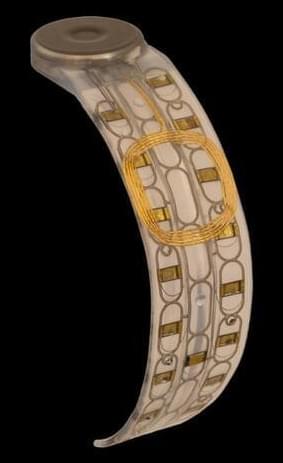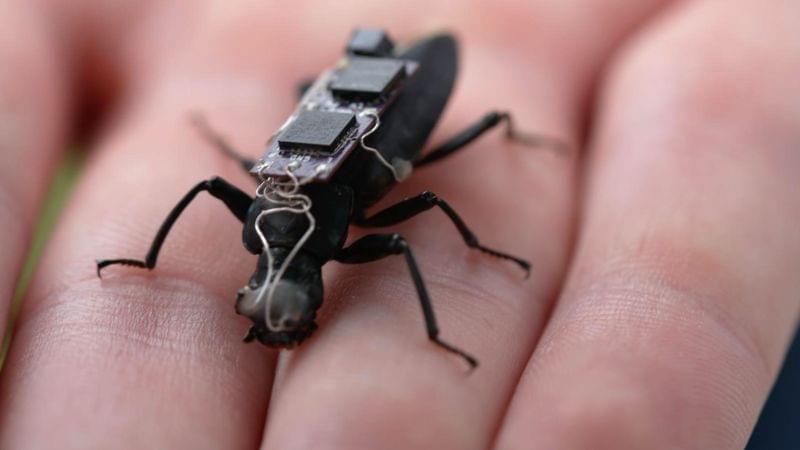The new system can turn cockroaches into cyborgs in under 70 seconds.


Researchers can mass-produce these cyborg cockroaches for disaster relief, surveillance, and environmental monitoring.
Researchers from Singapore have developed a new machine to automatically turn cockroaches into cyborgs in 68 seconds flat.

A year later, he got a myoelectric arm, a type of prosthetic powered by the electrical signals in his residual limb’s muscles. But Smith hardly used it because it was “very, very slow” and had a limited range of movements. He could open and close the hand, but not do much else. He tried other robotic arms over the years, but they had similar problems.
“They’re just not super functional,” he says. “There’s a massive delay between executing a function and then having the prosthetic actually do it. In my day-to-day life, it just became faster to figure out other ways to do things.”
Recently, he’s been trying out a new system by Austin-based startup Phantom Neuro that has the potential to provide more lifelike control of prosthetic limbs. The company is building a thin, flexible muscle implant to allow amputees a wider, more natural range of movement just by thinking about the gestures they want to make.

Science and Technology: Google said its quantum computer, based on a computer chip called Willow, needed less than five minutes to perform a mathematical calculation that one of the world’s most powerful supercomputers could not complete in 10 septillion years, a length of time that exceeds the age of the known universe.
Electronic skins (e-skins) are flexible sensing materials designed to mimic the human skin’s ability to pick up tactile information when touching objects and surfaces. Highly performing e-skins could be used to enhance the capabilities of robots, to create new haptic interfaces and to develop more advanced prosthetics.
In recent years, researchers and engineers have been trying to develop e-skins with individual tactile units (i.e., taxels) that can accurately sense both normal (i.e., perpendicular) and shear (i.e., lateral) forces. While some of these attempts were successful, most existing multi-axis sensors are based on intricate designs or require complex fabrication and calibration processes, which limits their widespread deployment.
Researchers at CNRS-University of Montpellier have introduced a new soft e-skin that leverages magnetic fields to independently detect forces on three axes. This e-skin, described in a paper published in Nature Machine Intelligence, has a simple design that could be easy to reproduce on a large scale.

Envisioning armies of electronically controllable insects is probably nightmare fuel for most people. But scientists think they could help rescue workers scour challenging and hazardous terrain. An automated cyborg cockroach factory could help bring the idea to life.
The merger of living creatures with machines is a staple of science fiction, but it’s also a serious line of research for academics. Several groups have implanted electronics into moths, beetles, and cockroaches that allow simple control of the insects.
However, building these cyborgs is tricky as it takes considerable dexterity and patience to surgically implant electrodes in their delicate bodies. This means that creating enough for most practical applications is simply too time-consuming.

Fitzgerald says cyborg search and rescue beetles or cockroaches might be able to help in disaster situations by finding and reporting the location of survivors and delivering lifesaving drugs to them before human rescuers can get there.
But first, the Australian researchers must master the ability to direct the movements of the insects, which could take a while. Fitzgerald says that although the work might seem futuristic now, in a few decades, cyborg insects could be saving lives.
He’s not the only roboticist creating robots from living organisms. Academics at the California Institute of Technology (Caltech), for example, are implanting electronic pacemakers into jellyfish to control their swimming speed. They hope the bionic jellies could help collect data about the ocean far below the surface.
▶️ Visit https://brilliant.org/NewMind to get a 30-day free trial + 20% off your annual subscription.
This video explores fascinating engineering solutions hiding in plain sight — ingenious designs that solve complex problems through elegant simplicity. From shoes that expand when stretched to windshields with hidden patterns, discover how everyday objects incorporate remarkable engineering innovations.
AUXETICS
These metamaterials that defy conventional physics by getting thicker when stretched. Follow their evolution from theoretical designs in 1978 to modern applications in athletic footwear and medical devices, and discover how precise geometric patterns create extraordinary properties that could revolutionize everything from prosthetics to architecture, despite challenging manufacturing requirements.
WINDSHIELD DOTS
The black dots on car windshields serve a dual purpose that revolutionized the automotive industry in the 1950s. This pattern manages extreme thermal stress during glass tempering while protecting crucial adhesive bonds. The precise ceramic frit application process has evolved to support modern safety systems and sensor integration, making these simple dots essential to modern vehicle design.
CURIE POINT HEATERS
Curie point heaters achieve temperature control through magnetic properties alone, eliminating complex control systems. These heaters maintain precise temperatures by becoming “magnetically invisible” at specific points. Modern implementations use sophisticated alloy combinations and multi-layer designs for unprecedented temperature control in medical sterilization and semiconductor processing.
TRIBOELECTRIC GENERATORS
I dream of wires cyborgization 2050 CE.
Gary Numan I Dream Of Wires (Extended Mix) Well what else can I say, I Dream Of Wires is a stunning track. I love it and I have tried to do a stunning Extended mix of it. Again, from the stunning early Gary Numan album Telekon.
I hope you enjoy it?
Enjoy.

bigsmile yay face_with_colon_three
An engineered cardiac patch has been created that incorporates human cells with flexible electronics and a nanocomposite structure to not only replace damaged heart tissue, but also provide remote monitoring, electrical stimulation, and the release of medication on demand. Using electroactive polymers and a combination of biological and engineered parts, the patch contracts and expands just like normal human heart tissue, but regulates those actions with the precision of a finely-tuned machine.
Invented by Professor Tal Dvir and PhD student Ron Feiner of Tel Aviv University (TAU), this new breakthrough medical device is claimed by its creators to have capabilities that surpass those of human tissue alone. As such, this patch may give new hope to people such as those 25 percent on the US national waiting list that may die before a suitable transplant heart becomes available, by effectively offering a way to fix – rather than replace – their own heart.
While a veritable horde of artificial and artificially-grown hearts are on the medical horizon (such as a silicone foam version from Cornell University and Berkeley’s heart grown on a chip), the wait for such things to be fully developed and come to market doesn’t help those facing the prospect of dying in the near future. This is the area where the TAU creation may prove to be the most valuable.
Researchers have engineered a material that is as soft as skin but remarkably strong.
Ulsan National Institute of Science & Technology (UNIST) team in South Korea has developed an innovative magnetic composite artificial muscle. This new material can adapt its stiffness, transitioning from soft to rigid, and vice versa.
Interestingly, artificial muscle showcases “an impressive ability to withstand loads comparable to those of automobiles.”